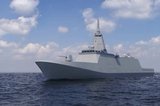Japan’s military enhances transport capability to offshore islands
This JMSDF transport ship LC-2002 is one of only a few Japanese vessels able to utilise small ports. (Photo: Koji Miyake)
The current maritime transport capability of the Japanese military is insufficient to transport troops and supplies to its southwest islands. The FY2023 budget is going some way to address this deficiency.
A logistics support vessel (LSV) and landing craft utility (LCU) will be built to enhance capability. Their construction cost is estimated at JPY10.8 billion ($83 million), and they will be delivered to the Japanese Maritime Self-Defense Force (JMSDF) in 2024.
The LSV, with a cargo capacity of 1,700t, will transport equipment from the mainland to Japan’s southwest islands. The LCU, meanwhile, with a payload capacity of 350t, will
Already have an account? Log in
Want to keep reading this article?
More from Naval Warfare
-
![US Navy to acquire micro-uncrewed underwater vehicles for ISR and coastal data collection]()
US Navy to acquire micro-uncrewed underwater vehicles for ISR and coastal data collection
The Naval Supply Systems Command is seeking authorised resellers of JaiaBot uncrewed underwater vehicles and multivehicle pods. The platforms will support undergraduate education at the US Naval Academy.
-
![Future of the Canadian Patrol Submarine Project is still unclear]()
Future of the Canadian Patrol Submarine Project is still unclear
The Canadian government remains tight-lipped on the timeline and funding required for the next steps of its Canadian Submarine Patrol Project, which should offer improved capabilities for the country’s navy.
-
![Mitsubishi eyes future with Australia’s Mogami selection]()
Mitsubishi eyes future with Australia’s Mogami selection
With Australia’s selection of the Mogami-class for Project Sea 3000, Mitsubishi is investigating local production in the next decade as potential export opportunities emerge.






















